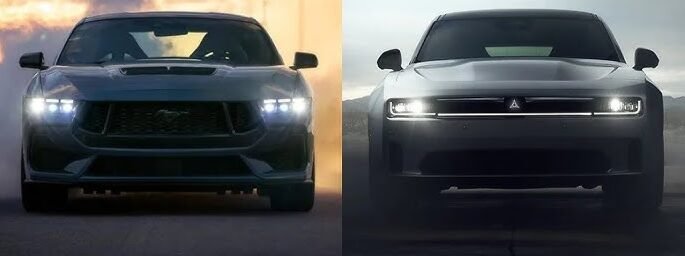The age of American muscle isn’t ending. It’s evolving.
In 2025, two legendary nameplates — the Dodge Charger and Ford Mustang — take on a new form. Both now wear electric badges, pushing performance into the future without losing the edge and presence that made them icons.
The 2025 Dodge Charger has returned as a bold electric coupe and four-door. The Ford Mustang Mach-E continues its run as a successful electric SUV with sporty roots. These two vehicles take very different design paths, but both aim to lead the electric performance space.
Which one should you choose? Let’s break down the design, power, range, tech, and pricing to help you decide between these two all-American EVs.
Design and Road Presence
Style matters in this matchup. These are not quiet commuter EVs. They’re here to turn heads.
2025 Dodge Charger EV
The Charger makes a dramatic return. This isn’t a mild evolution of the old model. The new EV version takes muscle car heritage and mixes it with futuristic sharpness. The coupe version features wide shoulders, a low stance, and LED lighting across the front. The front light bar gives it a distinct signature, and the new Fratzog logo marks a fresh chapter for Dodge’s design.
There’s also a four-door variant, allowing more practicality while keeping the bold styling. It looks like a concept car that escaped the auto show — and that’s the point. Dodge wants this car to look electric and loud, even without engine noise.
Ford Mustang Mach-E
The Mach-E plays a different game. It’s a compact crossover that borrows design cues from the Mustang coupe but builds them into a taller, more versatile package. Its front grille is closed and clean. The body has muscular fenders and a sloped rear roofline. In GT trim, it gets black trim, aggressive wheels, and red brake calipers.
The Mach-E doesn’t mimic the old Mustang — it reimagines the Mustang vibe for a new form factor. It’s less extreme than the Charger EV, but still sporty enough to make a statement.
Decision:
The Charger wins on boldness. It looks like a proper performance car in both two-door and four-door forms. The Mach-E leans into versatility but keeps a cool edge.
Power and Performance
This is where things get interesting. Both are electric. Both are quick. But their specs — and their target audiences — differ.
2025 Dodge Charger EV Power
- Base 340 trim: Around 455 horsepower
- Mid 440 trim: Around 590 horsepower
- Banshee model (coming soon): Expected over 800 horsepower
Dodge has not released full specs for every trim, but early reports show that even the base Charger is faster than the outgoing V8 model. The 340 and 440 versions refer to kilowatts, translating to serious horsepower. Acceleration is expected to be well under four seconds for the 440 model.
The Banshee version, when released, will be the flagship. It’s expected to have an 800-volt architecture and track-focused tuning. It’s Dodge’s answer to the Tesla Model S Plaid.
Ford Mustang Mach-E Power
- Select trim: 266 horsepower
- Premium and California Route 1: 290 to 325 horsepower
- GT trim: 480 horsepower, 600 lb-ft torque
- GT Performance Edition: 634 lb-ft of torque
The GT version of the Mach-E is fast. It hits 60 mph in 3.8 seconds. Power delivery is smooth, immediate, and addictive. While it doesn’t match the Charger’s expected top-end specs, it’s still one of the quickest compact electric SUVs on the market.
Decision:
The Charger has the edge in raw performance and future potential. The Mach-E GT is quick, but Dodge is aiming higher with more horsepower and track-ready engineering.
Driving Feel
Driving dynamics are about more than just numbers. They’re about how a car responds to the road.
Charger EV
Dodge is developing the Charger to feel like a true performance car. The weight is balanced thanks to the low battery placement, and all-wheel drive will be standard. Dodge is also working on simulated gear changes and sound systems to replicate the feel of shifting and revving — even in an EV.
It won’t be a lightweight car, but it will be sharp, with responsive steering and solid brakes. Dodge wants this to be fun, fast, and loud in all the ways that matter — even without a V8.
Mach-E
The Mach-E drives more like a tall hot hatch. It’s not as low or wide as the Charger, but the GT trim tightens the suspension and sharpens throttle response. One-pedal driving is available, and the steering is light but accurate.
On a twisty road, the Mach-E GT feels athletic for its size. It’s not a sports car, but it’s more fun than most electric crossovers.
Decision:
The Mach-E is more refined. The Charger is more raw. If you want edge, Charger wins. If you want balance, the Mach-E delivers.
Range and Charging
EVs live and die by range and charging speeds. Here’s how these two stack up.
Dodge Charger EV Range (Estimated):
- Base trims: Estimated 300 miles
- 440 trim: Likely around 280 miles
- Banshee model: Not confirmed
Dodge will use an 800-volt system in the Banshee model, which means very fast DC charging. Other trims will still support fast charging, but the official specs are still rolling out.
Ford Mustang Mach-E Range:
- Standard Range RWD: 250 miles
- Extended Range RWD: 320 miles
- GT Performance: 270 miles
The Mach-E has a solid track record with real-world range and supports DC fast charging up to 150 kW. That allows a 10 to 80 percent charge in about 45 minutes at a fast charger.
Decision:
Mach-E has proven numbers. The Charger is more powerful, but we’ll need confirmed data for range and charging times. For now, the Mach-E is the safer bet on range.
Interior Space and Tech
Both vehicles bring modern tech to the cabin, but their approaches differ.
Charger Interior
The Charger’s cabin is still under wraps in many trims, but early previews show a high-tech, driver-focused space. A large digital cluster and wide center screen dominate the dash. Ambient lighting, performance readouts, and a flat-bottom steering wheel are expected.
It’s likely to offer different layouts in two-door and four-door models, but both will emphasize performance over cargo. Expect optional sport seats, drive mode selectors, and a digital cockpit designed for driver engagement.
Mach-E Interior
The Mach-E’s cabin is minimal and clean. A 15.5-inch vertical touchscreen runs Ford’s latest software, while a small digital gauge display provides key info. The interface is simple, quick, and packed with features like wireless Apple CarPlay and Android Auto.
Rear seat space is solid, and the cargo area offers nearly 60 cubic feet with the seats folded. There’s also a front trunk for added storage. Heated seats, panoramic roof, and a B&O audio system are available.
Decision:
The Charger interior leans performance. The Mach-E offers more practicality and comfort for families.
Technology and Features

Here’s how the tech features compare:
Charger Expected Tech:
- Digital gauge cluster
- Large infotainment screen
- Custom performance drive modes
- Likely augmented performance sounds
- 4G/5G connectivity
- Over-the-air updates
Mach-E Tech Features:
- Sync 4 infotainment
- 15.5-inch vertical screen
- Wireless phone integration
- Ford BlueCruise hands-free highway driving (available)
- Over-the-air updates
- Phone-as-key function
Ford includes more driver assistance features standard. BlueCruise adds a layer of semi-autonomous driving that Dodge has not confirmed.
Decision:
Mach-E wins on daily tech features and comfort tools. Charger wins for performance-oriented tech.
Price and Trims
Pricing tells a big story. Here’s how these two compare.
Dodge Charger EV Pricing (Expected):
- Base 340 trim: Around $50,000
- 440 trim: Around $60,000
- Banshee: Expected over $80,000
Ford Mustang Mach-E Pricing:
- Select: $43,495
- Premium: $46,995
- California Route 1: $48,995
- GT: $59,995
- GT Performance: Around $63,000
The Mach-E has more accessible pricing. It also qualifies for tax credits depending on configuration and location. The Charger starts higher and aims to be a premium performance product.
Decision:
The Mach-E is more affordable across the board. The Charger EV targets buyers looking for maximum power and style.
Final Verdict: Which One Should You Choose?
Both the 2025 Dodge Charger EV and the Ford Mustang Mach-E represent where American muscle is headed next. They just take very different paths.
Buy the Charger if you want:
- Real performance-car looks and attitude
- Higher horsepower and performance potential
- All-wheel drive standard
- A coupe or four-door muscle EV experience
Buy the Mach-E if you want:
- A practical, family-friendly electric SUV
- Hands-free driving with BlueCruise
- Lower starting price
- Proven real-world range and charging
If you’re chasing bold design and raw electric muscle, the Charger is the future you’ve been waiting for. If you want versatility with style and strong performance, the Mach-E remains one of the best electric SUVs you can buy.
Either way, American performance is alive and electric — and your next car might just be one of these two.






